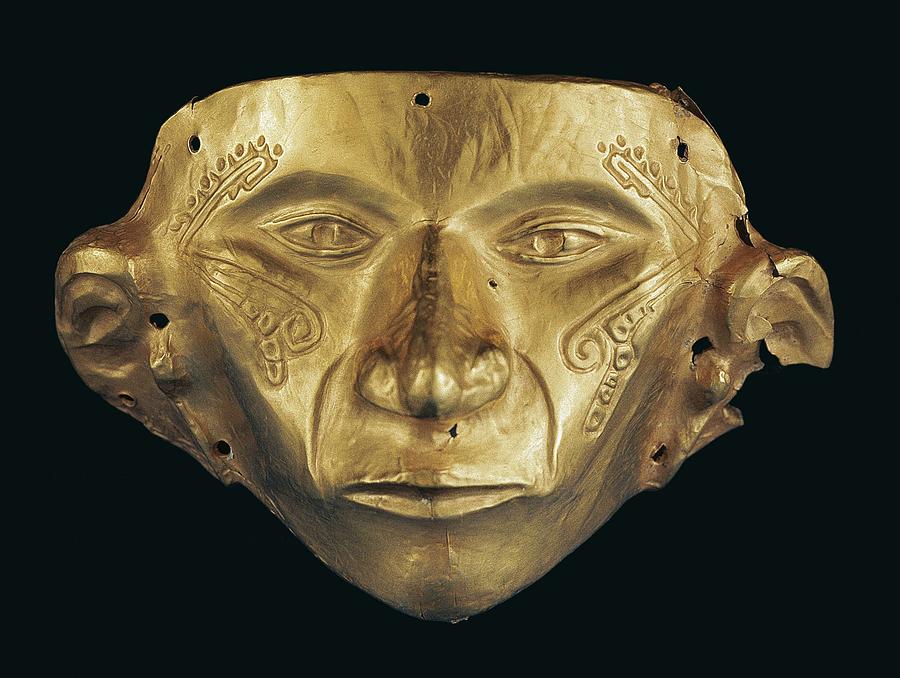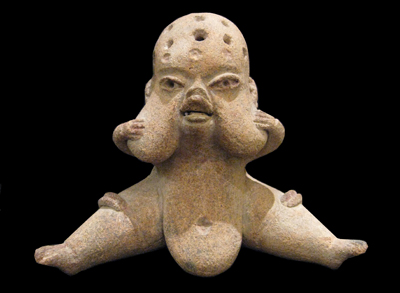Pre-Columbian art refers to the visual arts of indigenous peoples of the Caribbean, North, Central, and South Americas until the late 15th and early 16th centuries, and the time period marked by Christopher Columbus’ arrival in the Americas. Hunters and gatherers developed tools, traditions, and art that helped them survive and develop as a unique culture. For centuries, before the European invasion in the sixteenth century, they were creating amazing architectural monuments and everyday subjects (mainly by hand). Their work reflects their life and different belief systems that existed during that period of time. Most of their work includes metal, textiles, and, most importantly, sculptures.
 https://www.invaluable.com/buy-now/a-large-pre-columbian-nayarit-seated-male-figure-4904179880
https://www.invaluable.com/buy-now/a-large-pre-columbian-nayarit-seated-male-figure-4904179880
 https://fineartamerica.com/featured/gold-mask-pre-columbian-art-jewelry-everett.html
https://fineartamerica.com/featured/gold-mask-pre-columbian-art-jewelry-everett.html
The Pre-classic period was dominated by the highly developed Olmec civilization, which flourished around 1200–400 BCE. The Olmecs were the earliest known major civilization in Mexico following a progressive development in Soconusco. The Olmecs produced jade figurines, and created heavy-featured, colossal heads, up to 2 meters (8 ft) high. The Mesoamerican tradition of building large ceremonial centres appears to have begun under the Olmecs.
 http://www.abovetopsecret.com/forum/thread992421/pg1
http://www.abovetopsecret.com/forum/thread992421/pg1
Most of the sculptures were found buried with the people they belonged to. Pre- Columbian Americans believed in the afterlife – a transition into a different world after one’s death. They also believed that during that transition people needed their belongings. Therefore, burying sculptures, images, and symbols that the person could use in the following life was a common practice in the Pre- Columbian time.
During the Classic period the dominant Civilization was the Maya. Maya royalty commissioned artwork that honoured their achievements and secured their place in time. Maya script, also known as Maya glyphs, was the writing system of the Maya civilization of Mesoamerica and is the only Mesoamerican writing system that has been found. The earliest inscriptions found which are identifiably Maya date to the 3rd century BCE in San Bartolo, Guatemala. Maya script is extremely different from most other cultures. It is far more visually interesting than English writing, for example (see image below). It included images and symbols that only the Maya royalty was able to write and read.

Scenes depicting various rituals and historical events are embedded with hieroglyphic text to enable the viewer to identify the important figures, times and places instead of relying upon physical features that could be forgotten over time. The interpretation of the actions represented in the artwork goes hand in hand with understanding the decorative text that is woven into the picture. Unlocking this hieroglyphic text is vital as it removes anonymity and mystery from the scenes and reveals detailed records of those who held power throughout the timeline of the civilization.
https://www.youtube.com/watch?v=qi8nqmqIoqM
https://en.m.wikipedia.org/wiki/Pre-Columbian_art
http://www.ancientscripts.com/maya.html
https://design.tutsplus.com/articles/art-history-indigenous-south-america–cms-28629
this is so interesting to me i love history sometimes i would love to learn more from you guys